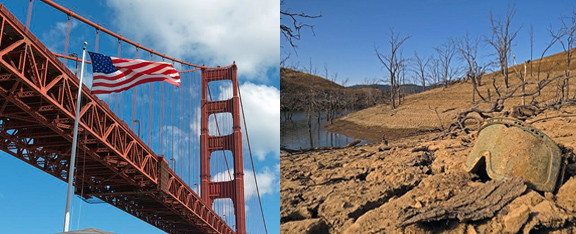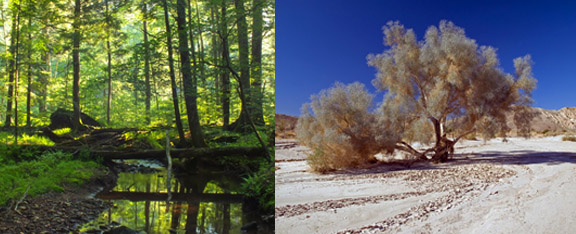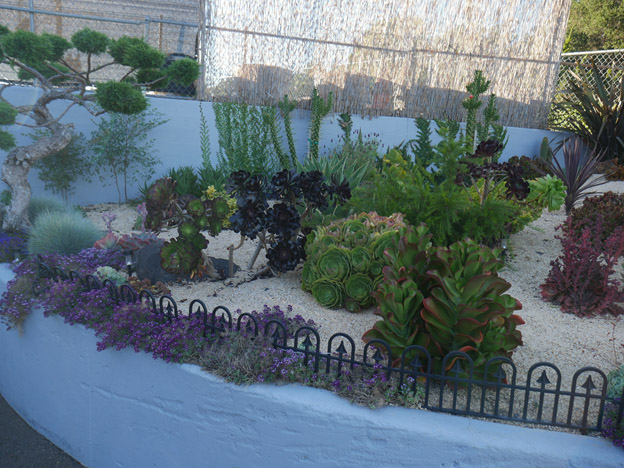What do we do when our way of life is fatally out-of-sync with our environment? Rachel Yang approaches this question through an analysis of the work of American writer and environmentalist Wallace Stegner. Engaging academic and journalistic sources, Yang interrogates Stegner’s “folklore of hope,” revealing the elitist underpinnings of the American Dream. As California’s forest fires increase in severity each year, Yang argues for the power of marginalized voices to dismantle the ideology of westward expansion. –Norma Jean Haynes, Ada Comstock ‘23, editorial assistant
The “Folklore of Hope” and the American Dream: California’s Drought and Wallace Stegner
Rachel Yang ’25

What will we do when the land around some of the most iconic symbols of American greatness, from the Hollywood sign to the Golden Gate Bridge, completely and irreversibly dries up? The environmental and economic damage of the California drought is only worsening: the annual fire season gets longer and more dangerous every year, and the cost of agricultural irrigation continues to rise. These are only two of countless indicators warning us to pay attention and to find a way to mitigate the drought. Three key texts fully realize the root causes of the drought and suggest a path forward: the writings of 20th century author and environmentalist Wallace Stegner, who frequently interrogated the implications of the infamous call to go West; the scholar Frederik Brøgger’s 2011 interpretation of Stegner’s writings with respect to a more contemporary California; and finally, the news article “California Drought Tests History of Endless Growth” by Adam Nagourney et al. discussing present-day California’s ongoing struggles with the drought. Brøgger identifies two frequent themes of Stegner’s writing fundamental to the connection between American ethos and western drought: the “folklore of hope” and the American Dream. Decades after Stegner, Nagourney et al. repeat these central illusions, demonstrating how they have continued to drive California’s growth through a cycle of drought that has devastated its environment, depleted the state’s resources, and most severely harmed the non-elite. Despite its reluctance to do so, California must finally break from mass American ideology and turn towards the ideas Stegner puts forth as authentic western identity to truly adapt to the aridity of the West and slow the state’s environmental damage.
Stegner deconstructs the origins of the American Dream and how it birthed the going-West narrative and the western phenomenon that Stegner dubs a “folklore of hope.” Upward mobility, the exploitation of natural resources, and growth at all costs were key to the individual-centered success that underpinned the original settlement and industrialization of the American Northeast. This approach, which prioritizes self-reliance and was first developed in northern Europe, translated well to the similarly-temperate Northeast; the American Dream was thus born (Stegner 61-2). Later settlers continued the migration of these ideas, chiefly that all unsettled land is a gateway towards future prosperity, as they went West (Stegner 57). But there, the American Dream was confronted by bone-dry climate and geography, starkly different from the lush forests and greenery of the Northeast (Stegner 62). Despite the incompatibility of individualist ideas like resource exploitation with a climate where resources were limited and cooperation necessary, settlers refused to accept the West’s aridity and manipulated the land under the illusions of upward mobility embedded within the narrative of the American Dream (Stegner 78). Stegner called this mass illusion the “folklore of hope” (Brøgger 4). This Californian manifestation of the American Dream lives on through the cultural idealizations of moving to Los Angeles and “making it big” or finding success in Silicon Valley, though the reality of this sentiment looks more like the Camp Fire of 2018. It continues to draw Americans west, deluding them to believe that arid desert can be turned into fertile fields with enough individual effort, and that the West is a wide expanse of resources, including unlimited water, waiting for whomever comes first.

Perhaps this mentality isn’t always a thing of folklore — the American Dream does have temporary and superficial functionality in California. It has helped propel the state’s growth to become the economic and population powerhouse it is today. Stegner describes the American Dream as a force that drives mass migration, “a new rush to the West fated, like the beaver and grass and gold rushes, to recede after doing great environmental damage” (86). The California fur and gold rushes of the 18th and 19th centuries embodied this cycle — the sudden emergence of an enriching resource attracting an influx of migrants hoping to get rich quick, followed by environmental exploitation and destruction. Those migrants bring with them their Northeastern assumption of natural abundance that simply does not exist in California or the rest of the West, but this insufficiency has consistently been ignored: “The assumption of cheap and abundant water has been a crucial part of California’s identity, history and economy” (Nagourney et al.). This assumption held true only for the first people to arrive, or the ones with the most advantages. After extracting every bit of the resource from the environment — destroying it along the way — the rest were left only with disappointment, not realizing that their eastern notions about resources had no place on western land. Stegner’s own parents experienced this second stage of the perpetual cycle: “‘[Stegner’s mother] had not education enough to know that the mass impulse that had… started her and my father from Iowa into Dakota and on across the border, had lost its legitimacy” in the arid West. “All she knew was that we were trapped and licked’” (Brøgger 4). We are now seeing the same rush cycle occur with Californian water, as the drought has made it clear that California’s prosperity will soon be limited by its lack of water, once again fulfilling the precedent set by the resource rushes of the past.

One of the reasons this rush cycle continues might be because its worst consequences most seriously impact the non-elite. Today, members of Silicon Valley and Hollywood are thriving in spite of the drought, but the laborers of the agricultural sector are suffering. These laborers and other non-elite workers in service and manufacturing industries are often not heard or mentioned in literature about California’s growth — for instance, Nagourney et al. quote almost exclusively from the state’s upper middle-class residents, academics, and government officials. When they mention the non-elite, it is only in the context of quotes from these elite individuals. Omitting the voices of those affected most by the drought threatens to hide its severity from those with the power to mitigate it, which only compounds the situation.
Stegner is not exempt from this silencing either. He briefly and offhandedly raises the existence of Native American water rights, but does not discuss how these rights have been reduced or ignored to benefit those who came to the West long after the tribes began using that water (Stegner 67). Additionally, Stegner discusses migrants from Mexico who came to California as farmworkers exclusively from the perspective of the farmers exploiting that labor, and only speculates how those farmers will be affected by immigration legislation (96). He never considers the perspective of these laborers, or how they, like his family, have been failed by the “folklore of hope.” Academia and journalism have in these instances failed to properly examine how California’s hardships are felt to the greatest degree by those outside the glamorous and rapidly growing industries that are easy to point to as signs of Californian greatness and the continued benefits of the American Dream. While fires burn through rural and agriculture-centered areas of the state, filming in Los Angeles studio lots and Silicon Valley technological production continue. Without hearing the voices of the non-elite, writers cannot capture the full scope of the issue or help their audiences realize that the beliefs key to American ideology cannot be perpetually applicable in the West. The state’s various natural biomes occupied by those removed from urban centers of elitism, from the chaparral of southern California to the conifer forests of the north, will not be able to withstand continued relentless exploitation of natural resources and land.

On the other hand, the Californian elite are still loud proponents of the American Dream, thereby strengthening the “folklore of hope” and only worsening the state’s issues of population density and water overuse. Hollywood continues to reproduce cliche celebrations of the Californian lifestyle, and the false hope of one major local politician continues despite the red flags. Nagourney et. al write:
Mayor Eric Garcetti of Los Angeles… said he was confident that the state would find ways to deal with an era of reduced water supplies, in a way that would permit it to continue to grow and thrive. ‘We have to deal with a new normal,’ Mr. Garcetti said. ‘That said, do we have enough water to sustain life here? Absolutely. Do we have enough water to grow economically? Absolutely.’ (Nagourney et. al)
Garcetti shows a mindless dedication to the ideas of the American Dream, somehow believing that reduced water usage will be able to support both the current magnitude of California’s population and future growth. His devotion to perpetual upward growth seems not to consider the limiting nature of the state’s water resources, which he refers to flippantly, as if this “new normal” will be silently accepted and will not impede growth in any way. He embodies the politicians that Stegner dubbed “boosters,” who in the late 19th century similarly impeded necessary actions to properly manage western water usage (Stegner 63-4). The “folklore of hope” deluded these boosters to the point that they believed that wood and water could be dug from the ground: “That kind of fantasy, like Cyrus Thomas’s theory that cultivation increases rainfall, that ‘rain follows the plow,’ would have to wait for the boosters” (Stegner 65). Just as with these boosters, the inability of California politicians like Garcetti and other members of the elite to understand the magnitude of the drought is dooming the state’s future.
Despite these misled politicians, there are some signs that California is beginning to break away from the folklore and dream and turn towards some of the ideas that Stegner promotes as authentic to the culture of the West. The beginning of a cultural shift can be seen in cities like Palm Springs, previously the American Dream incarnate, with its endless stretches of lush lawns and green golf courses. The drought is forcing this convention to change:
‘What Californians see as beautiful,” [Heather Cooley, water program director for a California environmental research group] said, ‘has been a lawn that has been the standard for front yards and backyards.’ Now, with utilities paying people to replace thirsty traditional grass turf with water-sipping native plants and other drought- tolerant shrubbery, long-held aesthetics are shifting. ‘This will change what Californians see as beautiful,’ she said. (Nagourney et al.)
The previous standard of a lush lawn is fundamentally American: the health of one’s lawn is simply a self-reliant manifestation of their personal efforts, a small realization of the American dream. By replacing this turf with desert natives like cactus and palo verde trees, there is a clear shift, albeit a superficial one, from the mass American ideology towards a more authentic western culture. The change adapts the state better to drought and its overall aridity, a process that must be continued and expanded to pull the state out of its current crisis. Stegner fixates on how the browns and tans of western deserts counter the lush greens of the rest of the country, and while this botanical shift may seem insignificant, it sets the stage for a larger cultural shift towards other elements of Stegner’s ideal West (68-9).

So how might this philosophical adaptation alter the behavior and priorities of Californians towards their surroundings? Stegner emphasizes the need for a sense of belonging in order to preserve the environment — if a place doesn’t feel like home, one has no incentive to maintain and protect it for future generations (Brøgger 8). Adaptation can only happen when residents are invested in the longevity of a place, and Stegner believes that this investment is only possible beyond the prevailing urbanism of the West (Brogger 8). The West can only realize itself, and break from the environmentally detrimental and incompatible ideology of the American Dream, in places with strong local identity and community. Stegner celebrates “‘towns and cities still close to the earth, intimate and interdependent in their shared community, shared optimism, and shared memory. These are the seedbeds of an emergent western culture’” (qtd. in Brøgger 6). The state needs to become less densely populated, decreasing to a population size that is sustainable in the long term with California’s water supply, and build a system of fixed, interdependent communities. Gone would be the big booming cities celebrated and bolstered by the American Dream and fed with the propaganda of the “folklore of hope”; instead, we would see a Californian mindset based on sustainability and maintaining communities, rather than a perpetual growth mentality.
California’s growth has been a cycle of mass influx and resource depletion driven by the ideas of the American Dream after settlers carried it from Eastern urban centers to the West. The land simply cannot provide for the false narrative of the American dream any longer. It is imperative for the state to finally begin listening to its non-elite and understand that it is time to deviate from the self-reliant exploitation baked into the “folklore of hope” before further damage is done to the environment. The state needs to encourage some of its population to flow into other areas of the country, perhaps back to the Eastern cities where the American Dream was born. There are already programs in place that draw Californians away — one in West Virginia provides a moving incentive of over $12,000, and there were more applicants selected from California than from any other state (Farmer). By subsequently creating a sense of home with smaller communities made up by the remaining population, the state can foster a more widespread mentality of responsibility for the environment and its future. Although this communitarian version of the West that Stegner cherishes runs counter to the individualistic American Dream, which secured Californian prosperity, it may be the only version that can survive in the new age of climate change.
Works Cited
Amstutz, Ben. “California Drought 2015.” Openverse, 2015, https://search-production.openverse.engineering/image/ebeb89fc-7ed4-4706-b2da-571fd086dd52.
Brøgger, Frederick Chr. “Wallace Stegner and the Western Environment: Hydraulics, Placelessness, and (Lack of) Identity.” European Journal of American Studies, vol. 6, no. 3, Sept. 2011, https://doi.org/10.4000/ejas.9302.
Farmer, Liz. “West Virginia Is Luring Californians Away With Its $12,000 Moving Incentive.” Forbes, 2 Sept. 2021, https://www.forbes.com/sites/lizfarmer/2021/09/02/west-virginia-is-luring-californians-away-with-its-12000-moving-incentive/.
Highsmith, Carol. “Golden Gate Bridge and Fort Point, San Francisco, California.” Library of Congress, 2012, https://www.loc.gov/pictures/item/2013630389/.
Lange, Dorothea. “Mexican field worker, father of six. Imperial Valley, Riverside County, California.” Library of Congress, 1935, https://www.loc.gov/pictures/item/2017759521/.
“Lights and freedom.” “Drought-tolerant CV2.” Wikimedia Commons, 2022, https://commons.wikimedia.org/wiki/File:Drought-tolerant_CV2.jpg.
Nagourney, Adam, et al. “California Drought Tests History of Endless Growth.” The New York Times, The New York Times Company, 4 Apr. 2015, https://www.nytimes.com/2015/04/05/us/california-drought-tests-history-of-endless-growth.html.
Nicholas_T. “Tionesta Research Natural Area (Revisited) (2).” Flickr, 10 Jun. 2012, https://www.flickr.com/photos/14922165@N00/7359946398.
Scrubhiker (USCdyer). “Ghosttree in Anza-Borrego California Desert Park.” Flickr, 18 Feb. 2013, https://www.flickr.com/photos/48148847@N04/8512294962.
Serrell, Henry, and S. Lee Perkins. “A California gold hunter meeting a settler.” Library of Congress, date unknown, https://www.loc.gov/pictures/item/2003674381/.
Stegner, Wallace. Where the Bluebird Sings to the Lemonade Springs: Living and writing in the West. Random House, 1992.
Recent Comments